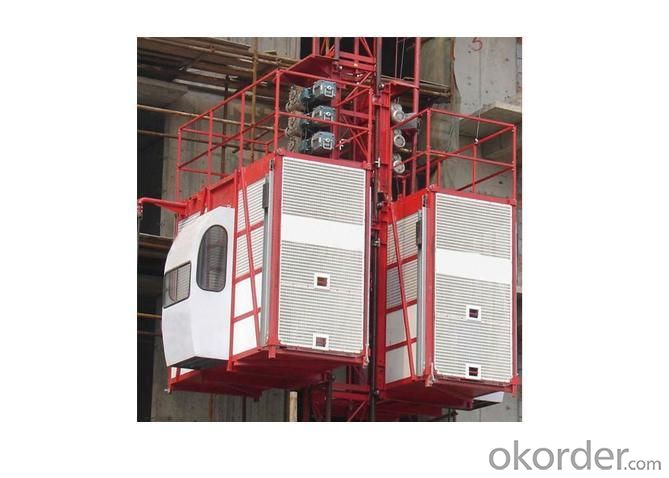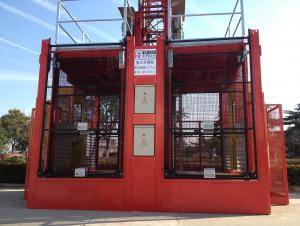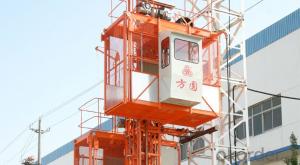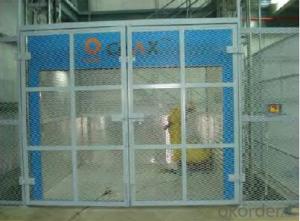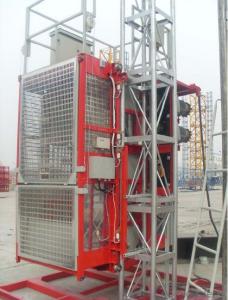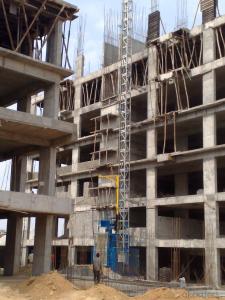Twin Cage Construction Hoist SC200/200
- Loading Port:
- China Main Port
- Payment Terms:
- TT or LC
- Min Order Qty:
- 1 Set set
- Supply Capability:
- 10 Sets per Month set/month
OKorder Service Pledge
OKorder Financial Service
You Might Also Like
Detailed Twin Cage Construction Hoist SC200/200 Product Description
the elevator runs along the tower mast section, it is different from the elevator with wire rope system ( like the passenger lift in the building), from the attached photo you can see on the back side of cargo platform there is one tower mast section.
Specification of Twin Cage Construction Hoist SC200/200
SC200/200 Construction hoist | |||
Specifications | Unit | Parameter | |
Max Load | Kg | 2×2000 | |
Max Passengers | 2×20 | ||
Rated Lifting Speed | m/min | 34 | |
Max Lifting height | m | 300 | |
Max Free End Height | m | ≤7.6 | |
Modulus of Gear Rack | 8 | ||
Carriage Weight | Kg | 1012×2 | |
Size of Carrige | m | 3.0×1.3×2.4 | |
Standard Knot Weight | kg | 145 | |
Standard Knot Length | m | 1.508 | |
Cross-section Size of Standard Knot | 0.65×0.65 | ||
Motor | Model | YZE132M-4 | |
Rated Power | KW | 11×3×2 | |
Necessary Electric Power | KVA | 22×3×2 | |
Reducer | Center Distance | mm | 125 |
Transmission Ratio | 1:16 | ||
Overspeed Governor | Type | Progressive | |
Model | SAJ40-1.2A | ||
Operation speed | m/min | 49.5 | |
Brake moment | N.m | 2600 | |
Hoist weight | t | 22 | |
- Q: This question asks for the cost associated with purchasing and installing a building hoist.
- <p>The cost of buying and installing a building hoist can vary significantly depending on several factors. The type and capacity of the hoist, the height of the building, and the complexity of the installation are key determinants. On average, the cost can range from $10,000 to $50,000 for the hoist itself, with installation costs potentially adding another 20-50% to the total. However, for very tall buildings or specialized hoists, the price can exceed $100,000. It's crucial to obtain quotes from multiple suppliers and installers to get an accurate estimate for your specific project.</p>
- Q: Is it possible to use personal components to fix a malfunctioning building hoist?
- <p>While it might be tempting to use your own parts to repair a malfunctioning building hoist, it is generally not recommended. Building hoists are complex pieces of machinery that require specific components to function safely and efficiently. Using non-standard parts can lead to further damage, safety hazards, and may void any warranty on the hoist. It's crucial to use parts that meet the manufacturer's specifications to ensure the hoist operates correctly and safely. Always consult with a professional or the manufacturer for repair advice and parts.</p>
- Q: Excuse me: what is the meaning of heavy weight in the construction elevator?
- With double cage for heavy, namely SCD200/200 series Is the two cages, each cage has a corresponding weight, the weight up and down in the elevator cage rise to energy conservation and reduce the reaction between the up and down, when you imagine front-rear door principle is about the same
- Q: Can a building hoist be utilized to lift more than one object simultaneously?
- <p>Yes, a building hoist can be used to lift multiple objects at once, provided that the combined weight of the objects does not exceed the hoist's maximum load capacity. This is often done by securing all objects to a single lifting point or using a pallet or platform to hold the objects together. It's crucial to ensure that the hoist is rated for the total weight and that the objects are evenly distributed to maintain balance during lifting. Always follow safety guidelines and manufacturer's instructions to prevent accidents.</p>
- Q: The question asks about the typical duration a building hoist can function before needing replacement or significant repair.
- <p>The lifespan of a building hoist can vary significantly based on factors such as usage frequency, maintenance, and the quality of the hoist itself. Generally, with proper care and regular maintenance, a building hoist can last anywhere from 10 to 20 years. However, heavy usage and inadequate maintenance can shorten this lifespan, while some high-quality hoists may exceed the average lifespan with fewer issues.</p>
- Q: Is it possible to use two lifting devices simultaneously to lift an object that is heavier than the maximum weight each device can handle individually?
- <p>Yes, two lifting devices can be used together to lift a heavier object than either one can handle alone, provided that both devices are capable of supporting the combined weight and are properly synchronized. This requires careful planning and coordination to ensure the safety of the operation and the integrity of the lifting devices. The total weight capacity of the combined system should be greater than the weight of the object being lifted, and the devices must be designed to work in tandem without overloading or causing damage.</p>
- Q: This question asks for a comparison of the benefits and drawbacks of employing lifting equipment in the construction industry.
- <p>Advantages of using lifting equipment in construction include increased efficiency, reduced manual labor, and the ability to handle heavy loads safely. It can also improve safety by reducing the risk of injury from lifting heavy objects manually. Additionally, it allows for faster construction times and can access hard-to-reach areas. Disadvantages include high initial costs for purchasing or renting the equipment, potential for mechanical failure, and the need for skilled operators. There is also a risk of accidents if the equipment is not used properly, and it may require more maintenance and training for staff.</p>
- Q: This question asks whether a building hoist can be utilized for lifting both fragile and non-fragile items.
- <p>Yes, a building hoist can be used for lifting both fragile and non-fragile objects. However, it is crucial to ensure that the hoist is equipped with the appropriate attachments and safety measures to handle fragile items without causing damage. For non-fragile objects, the hoist can be used more freely, but still, safety protocols must be followed to prevent accidents. The key is to use the hoist within its weight capacity and to adhere to all operational guidelines to ensure the safe and effective lifting of all types of objects.</p>
- Q: Whether the construction elevator is a dual-purpose elevator
- Very simple check, the construction elevator is in the construction site, not completely closed, and the human cargo is used commonly in the mall and the factory, is completely closed.
- Q: Is it safe to use a lifting device with someone who has no experience with it?
- <p>It is generally not advisable to use a lifting device with someone who is not familiar with it. Lifting devices require proper training and understanding of their operation to ensure safety. Using such equipment without proper knowledge can lead to accidents and injuries. It is crucial to ensure that anyone operating a lifting device has received the necessary training and is familiar with the specific device's safety protocols and operation procedures.</p>
1. Manufacturer Overview
| Location | Hebei,China |
| Year Established | 2005 |
| Annual Output Value | |
| Main Markets | North America, South America, Eastern Europe, Southeast Asia, Africa, Oceania, Mid East, Eastern Asia, Western Europe, Central America, Northern Europe, Southern Europe, South Asia |
| Company Certifications |
2. Manufacturer Certificates
| a) Certification Name | |
| Range | |
| Reference | |
| Validity Period |
3. Manufacturer Capability
| a) Trade Capacity | |
| Nearest Port | |
| Export Percentage | |
| No.of Employees in Trade Department | |
| Language Spoken: | |
| b) Factory Information | |
| Factory Size: | |
| No. of Production Lines | |
| Contract Manufacturing | |
| Product Price Range | |
Send your message to us
Twin Cage Construction Hoist SC200/200
- Loading Port:
- China Main Port
- Payment Terms:
- TT or LC
- Min Order Qty:
- 1 Set set
- Supply Capability:
- 10 Sets per Month set/month
OKorder Service Pledge
OKorder Financial Service
Similar products
Hot products
Hot Searches
Related keywords

